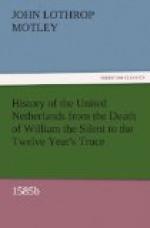With such municipal machinery and such coadjutors had Sainte Aldegonde to deal, while, meantime, the delusive French negociation was dragging its slow length along, and while Parma was noiselessly and patiently proceeding with his preparations.
The burgomaster—for Sainte Aldegonde, in whom vulgar ambition was not a foible, had refused the dignity and title of Margrave of Antwerp, which had been tendered him—had neglected no effort towards carrying into effect the advice of Orange, given almost with his latest breath. The manner in which that advice was received furnished a striking illustration of the defective machinery which has been pourtrayed.
Upon his return from Delft, Sainte Aldegonde had summoned a meeting of the magistracy of Antwerp. He laid before the board the information communicated by Orange as to Parma’s intentions. He also explained the scheme proposed for their frustration, and urged the measures indicated with so much earnestness that his fellow-magistrates were convinced. The order was passed for piercing the Blauw-garen Dyke, and Sainte Aldegonde, with some engineers, was requested to view the locality, and to take order for the immediate fulfilment of the plan.
Unfortunately there were many other boards in session besides that of the Schepens, many other motives at work besides those of patriotism. The guild of butchers held a meeting, so soon as the plan suggested was known, and resolved with all their strength to oppose its execution.
The butchers were indeed furious. Twelve thousand oxen grazed annually upon the pastures which were about to be submerged, and it was represented as unreasonable that all this good flesh and blood should be sacrificed. At a meeting of the magistrates on the following day, sixteen butchers, delegates from their guild, made their appearance, hoarse with indignation. They represented the vast damage which would be inflicted upon the estates of many private individuals by the proposed inundation, by this sudden conversion of teeming meadows, fertile farms, thriving homesteads, prolific orchards, into sandy desolation. Above all they depicted, in glowing colours and with natural pathos, the vast destruction of beef which was imminent, and they urged—with some show of reason—that if Parma were really about to reduce Antwerp by famine, his scheme certainly would not be obstructed by the premature annihilation of these wholesome supplies.
That the Scheldt could be, closed in any manner was, however, they said, a preposterous conception. That it could be bridged was the dream of a lunatic. Even if it were possible to construct a bridge, and probable that the Zeelanders and Antwerpers would look on with folded arms while the work proceeded, the fabric, when completed, would be at the mercy of the ice-floods of the winter and the enormous power of the ocean-tides. The Prince of Orange himself, on a former occasion, when Antwerp was Spanish, had attempted to close the river with rafts, sunken piles, and other obstructions, but the whole had been swept away, like a dam of bulrushes, by the first descent of the ice-blocks of winter. It was witless to believe that Parma contemplated any such measure, and utterly monstrous to believe in its success.




